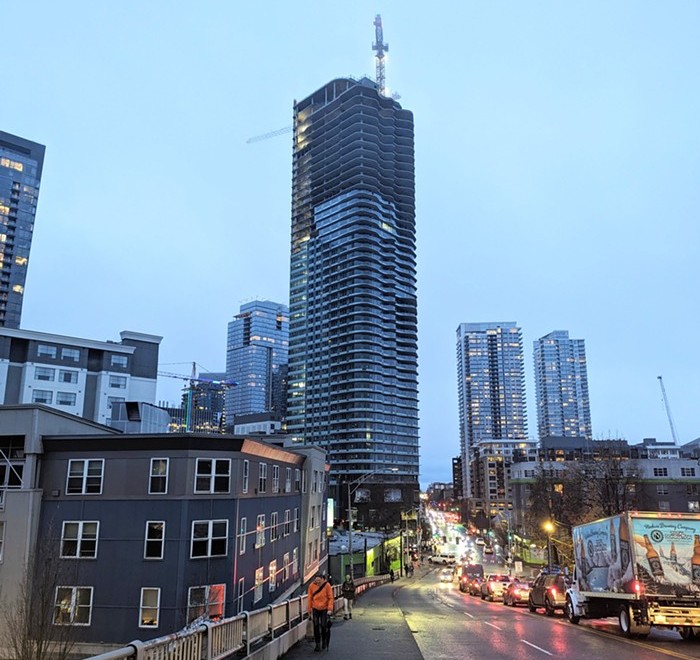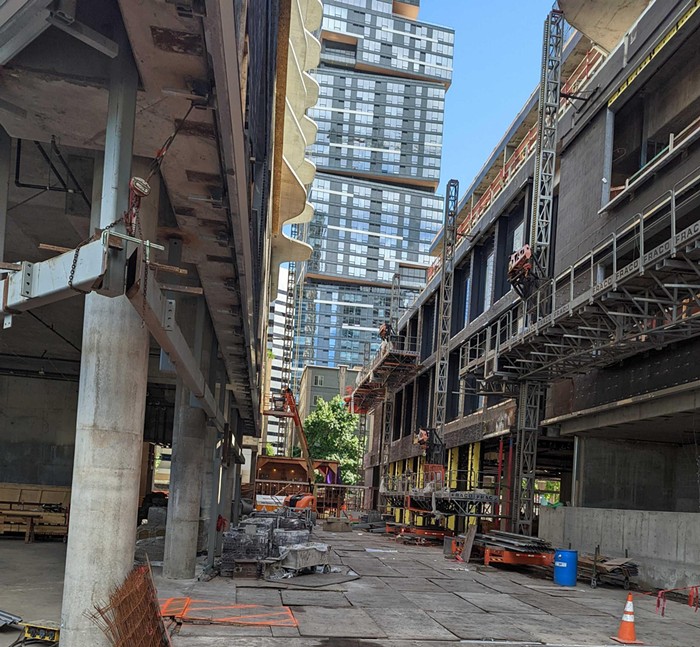
A month before the U.S. plunged into one of the most maddening presidential elections in history, Marc Stiles, a senior staff writer at the Puget Sound Business Journal, reported that Seattle had reclaimed the top of the Rider Levett Bucknall Crane Index (RLB) for the US. At that time the city had 43 cranes raising towers and other large works around town. (Los Angeles ranked second with 42 cranes; Washington, D.C. ranked third with 38; and Portland, Oregon ranked fourth with 27. Toronto, Canada's New York City, led the North American index with an unbelievable 124 cranes.)
These new Seattle projects have only contributed to the feeling that Seattle, whose construction boom has entered its 8th year (the consensus is that it began in 2013), is more and more unrecognizable.
Indeed, while walking to the bus stop next to the Whole Foods in South Lake Union the other day, I looked up a street I once knew (it's next to Cornish College's Main Campus Center), and found myself in the same state of astonishment that grips Ariadne (Elliot Page) during the "city bending" scene in Christopher Nolan's masterpiece Inception.
In the way Nolan's Paris has, in a state of a dream, completely severed its ties with reality, Seattle, in a hyper-state of capitalist speculation, is no longer moored to anything that can be explained with the standard interpretive tools available to almost all who diffuse orthodox economic ideas in the university system and in mass media.
The answers for Seattle's rapid transformation are not found in all of Adam Smith's nearly 1000-page book, The Wealth of Nations, except for possibly in a very brief section on rapscallion schemes around the discounting of bills exchange. Nor are the answers found in anything that has come out of the University of Chicago and other freshwater (and the bulk of saltwater) institutions. The answer is found in two obscure movements in economic history.
One is found in an economic genealogy that dumps Smith, David Ricardo, and even John Maynard Keynes and replaces them with one that begins with Bernard Mandeville's The Fable of The Bees: or, Private Vices, Publick Benefits, and by Werner Sombart's Luxury and Capitalism, and also Thorstein Veblen's The Theory of the Leisure Class. The description of this other and mostly ignored (by the right and left) genealogy of capitalist economics is found in Noam Yuran's What Money Wants: An Economy of Desire. Its key logic is that capitalism is not about the production and distribution of things people actually need, but rather the production of luxuries. This is why much of the new Seattle makes no sense to the majority of those who live in Seattle. Our city is in the same realm as the future hotel in space.
I just want health insurance, these muhfuckas got space hotels
— DAVID MUNSELL, WOODCHUCK FROM 3RDST,414. (@davidmunsell333) March 2, 2021
But one must couple Yuran's luxury-motive genealogy with Rose Luxemburg's 1913 book, The Accumulation of Capital.
This work links to two thinkers (one before it, Mikhail Tugan-Baranovsky; and one after it, Michał Kalecki) to form a triangle of economic theory that has as its impetus the section on simple and expanded reproduction in chapter 20 of Marx's second volume of Das Capital. The basic (or monstrous) idea is that since the Dutch revolution, capitalist expansion has always taken the form of loaning itself to itself.
Now, one might rightly read this as a perfectly reasonable thing. It's like the law of supply and demand. This is how an economy advances, and so on. But when it is examined closely by the bright likes of Luxemburg and Tugan-Baranovsky, it's revealed to be as fantastic as that beanstalk in the famous fairy tale. Capital from elsewhere is ultimately answered by the demand of capital. Capitalism only works successfully if it buys itself. If it sells itself to itself. It tells itself to believe in itself. And the more this itself believes it is who it is, the faster and faster it will grow. Capitalism is not about an outside and inside, but always an inside.

This is Seattle's new skyline. It is one that can go on as long as capitalism mirrors the buyer. If that specular relationship holds, then more buildings in this city will continue to fly up and stun us like a bending city.















